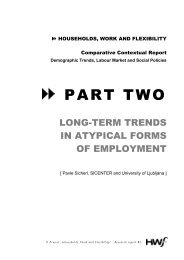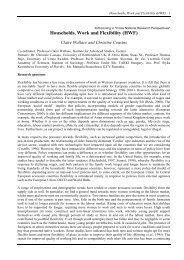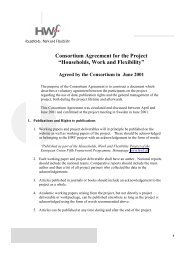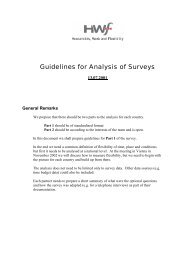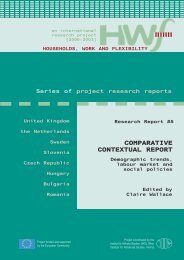CRITICAL REVIEW OF LITERATURE - HWF
CRITICAL REVIEW OF LITERATURE - HWF
CRITICAL REVIEW OF LITERATURE - HWF
You also want an ePaper? Increase the reach of your titles
YUMPU automatically turns print PDFs into web optimized ePapers that Google loves.
Chapter Six. Literature review: Czech Republic 125INTRODUCTIONAt the outset we have to admit that it is very difficultto find any literature concerning work andhousehold flexibility in the Czech Republic. Theexplanation for this may be twofold. On the onehand, appropriate data are lacking, and on theother, long-term policies aimed at improvingflexibility have not been perceived as urgentlyimportant by policymakers in the early years oftransition, when employment was high due togenerous state support of large firms.Currently the issue of work flexibility hasbeen perceived as adverse to the social and economicpolicies of the Social Democratic government.No attempts to examine time budgets orhousehold work patterns have been made by theCzech Statistical Office since 1989, and only standardvariables concerning work contracts are describedin Labor Force Surveys. Sociological surveys,however, can provide some deeper insight.Here we have collected scarce available informationwhich is indirectly provided by the feweconomic and sociological studies that deal withour themes. Concretely speaking, we are drawingon three different sources that are partially relatedto work and household flexibility: labor economicsliterature, social reporting and gender studies.This is only a brief review of studies and literature.Most of the relevant information is yet to becollected and our work will be resumed in ourLabor market and work flexibility in the Czech Republic:Trend overview (see Vecernik and Stepankova2001).1. LABOR MARKET1.1. Job transitionsMost analyses of labor market flexibility use aggregatedata and examine transitions betweenthree employment states (unemployment, employment,out of labor force) and job-to-jobmovements. In 1993-1996, annual flows beweenthese states increased to include up to 20 percentof the labor force. Over half of the movementsconsisted of mobility between employment andeconomic inactivity, one-third between employmentand unemployment, and over one-tenth betweeneconomic inactivity (early retirement anddisability retirement, study and maternal leave)and unemployment.Moreover, nearly 40 percent of the laborforce had moved voluntarily to another employerduring 1992-1997, mainly within the same sectors(Flek and Vecernik, 1999). Conversely, Gottvald(1999) uses Labor Force Survey (LFS) data andcalculates the one year gross transition probabilitiesfor 1993-1998. However, he did not find suchfrequent changes of employment using this dataset. Moreover, he stresses that the probabilities ofremaining unemployed, employed, and out of thelabor force are increasing in time, which impliesthat the magnitude of flows between states – animperfect measure of flexibility – is actually decreasing.© Project „Households, Work and Flexibility”. Research report #1



